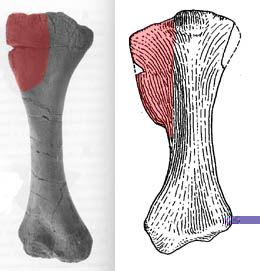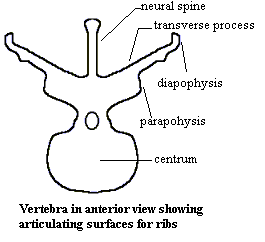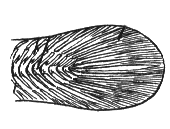
| Palaeos: |  |
Glossary |
| The Vertebrates | D |
| Page Back | Unit Back | Unit Home | Unit Dendrogram | Unit References | Glossary | Taxon Index |
| Page Next | Unit Next | Vertebrates Home | Vertebrate Dendrograms | Vertebrate References | Bones | Timescale |
For most phrases beginning with directional words, e.g. "posterior," "dorsal," "external," etc., or some generic anatomical terms, e.g., "vena," look under the next word in the phrase. However, note that this convention is not used with complete consistency in this Glossary.
D: Devonian
Dacriform: shaped like a tear drop.
Dactylo-: Gr. root = "finger."
Dapingian Age: The first age of the Middle Ordovician Epoch, 472-468 Mya. See Dapingian.
Darbasa Formation: Late Cretaceous (Campanian) of southern Kazakh.
Darriwilian: Second Age of the Middle Ordovician Epoch, 468-461 Mya. See Darriwilian.
Deccan Intertrappean: various deposits preserved between layers of the Deccan Traps, the enormous volcanic outpouring in North and Central India during the latest Late Cretaceous (Late Maastrichtian), ~65 Mya. For various reasons, the preservation is usually not very good, but the Traps are full of fascinating and suggestive bits and pieces.
Deciduous: of mammalian dentition, relating to "baby" teeth.
Delorme Group: Early and Middle Silurian of Arctic Canada. Thelodonts. Soehn et al. (2001).
Delphy-: Greek root for "womb."
 Deltopectoral
crest: a longitudinal ridge or crest on the (proximal) humerus. See
figure. Cursorial forms typically do not have a large crest. It is
typically an important attachment point for adductors, rather than retractors.
See Humerus.
Deltopectoral
crest: a longitudinal ridge or crest on the (proximal) humerus. See
figure. Cursorial forms typically do not have a large crest. It is
typically an important attachment point for adductors, rather than retractors.
See Humerus.
Dendrodont: dentition marked by dentine with primary and secondary folds; secondary folds filled in with attachment bone.
Dens: L. dens, dentis = "tooth". Can refer to any number of tooth-shaped structures. Most commonly, the peg on the axis which articulates with a pit on the atlas. See fovea dentis.
Dental formula: a formula, which may be written in a variety of ways, showing the number of upper and lower incisors, canines, premolars and molars, in that order. In these Notes, the formula is typically written: 2/1, 0/0, 4/3-4, 3/3. This would indicate that the animal has, on each side, 2 upper incisors, 1 lower incisor, no canines, 4 upper premolars, 3 or 4 lower premolars, and 3 upper and 3 lower molars. Partial formulas may be written, e.g. I2/2: two upper and two lower incisors.
Dentary peduncle: in mammaliforms, the stem which bears the dentary's articulation with the squamosal. That is, the process on which the dentary's contribution to the temporomandibular (jaw) joint is built.
Denti-: L. root = "tooth" (dens, dentis).
Denticle: a "tooth-let," i.e. a small protuberance having the characteristic histology of teeth (typically enamel + dentine + pulp cavity), but small and without roots.
Denticulate, Denticulated: characterized by having denticles.
Dentigerous: same as denticulate
Dentine: dense, highly mineralized bone formed by mineralization of a collagen matrix by odontoblasts, mesenchyme-derived cells which form tubules in the dentine as they travel through it. The pattern of tubules is often used to subdivide dentine into various types, e.g. orthodentine, mesodentine.
Dermal bone: bone which is formed directly, rather than pre-formed in cartilage.
Dermatocranium is composed of plates of dermal bone that cover the head and protect the brain and gills. Six basic groups of dermal bones make up the dermatocranium: the facial, orbital, temporal, vault, palatal and mandibular series.
Dermatome: See Early Development Terms.
 Dermintermedial Process:
A large or small bump on the floor or wall of the naris in some sarcopterygians,
generally cosmine covered in
cosmine-covered fishes. This bump has led to endless arguments about
whether one or the other species has a true choana (nasal opining inside the
mouth), because the derimintermedial process may represent the fusion of two external
nasal openings. In recent years, the presence or absence of the choana has
not been given as much phylogenetic importance as it once had. It is simply one
more character among many. Thus, the debates involving this structure have
generally subsided.
Dermintermedial Process:
A large or small bump on the floor or wall of the naris in some sarcopterygians,
generally cosmine covered in
cosmine-covered fishes. This bump has led to endless arguments about
whether one or the other species has a true choana (nasal opining inside the
mouth), because the derimintermedial process may represent the fusion of two external
nasal openings. In recent years, the presence or absence of the choana has
not been given as much phylogenetic importance as it once had. It is simply one
more character among many. Thus, the debates involving this structure have
generally subsided.
Dermopalatine: same as palatine. The prefix is used by fish people because the palatine is a dermal replacement bone for a section of the autopalatine section of the palatoquadrate. In that context, palatine is potentially ambiguous.
Deseaden: South American Land Mammal Age corresponding to the Late (possibly Early) Oligocene.
Desmognathous: of birds, a condition of the palate characterized by vomers small or absent, maxillopalatines in contact in midline, pterygoids and palatines articulate with basisphenoidal rostrum.
Deuterostomes: All triploblasts closer to the early bird than to the worm. Deuterostomes (as opposed to protostomes) are characterized by development of the blastopore into the anus, rather than the mouth. The major deuterostome taxa are the Echinodermata and Chordata. Actually, in our treatment of the group, we use an alternate, crown group definition: "sea stars + movie stars." See Deuterostomia.
Devonian: The fourth period of the Paleozoic Era. The Devonian Period includes the time from 417 to 354 Mya. The Early Devonian comprises the Lochkovian, Praghian and Emsian Ages (417-391 Mya). The Middle Devonian includes the Eifellian and Givetian Ages (391-370 Mya); and the Late Devonian is divided into the Frasnian and Famennian Ages (370-354 Mya). The Devonian is the "Age of Fishes" between the Silurian and Carboniferous Periods.
Dexter, Dextral: Latin for right, toward the right, etc.
Di-: Gr. root = "two".
Diamictite: see Tillite.
Diaphragm: generally, a muscular partition. In mammaliforms, the diaphragm is analogous to pulmonary fold (see pleural cavity), but is formed from a dorsal process of the coelom itself which is invaded by migrating cervical mesenchymal cells. The mesenchyme differentiates into neuromuscular tissue which creates a muscular diaphragm bringing ventilation under direct muscular control. Reptiles possess a similar (analogous? homologous?) diaphragm, but posterior to the liver, which is also involved in hepatic pump ventilation in, for example, crocodylians and probably some dinosaurs.
Diaphysis: the middle, shaft region of long bones which is usually fully ossified and contains the medullar cavity ("marrow"). As opposed to the metaphysis and epiphysis.
 Diapophysis:
upper, articulating process of transverse process of the neural arch; typically
bears the secondary (tubercular) articulation of the ribs. For a better picture,
see Untitled
Document.
Diapophysis:
upper, articulating process of transverse process of the neural arch; typically
bears the secondary (tubercular) articulation of the ribs. For a better picture,
see Untitled
Document.
Diarthrodial: freely moveable joints, such as the knee, as opposed to slightly moveable (amphiarthrodial) or immoveable (synarthrodial), such as the back and sutural joints, respectively.
Diastataxy (= Diastaxis): having a wing lacking a secondary feather associated with the fifth secondary covert. Adj: diastaxic. Opposite of eutaxic.
Diastema: a gap in the tooth row or (rarely) a gap in some other series of structures.
Dichocephalous: of ribs, having two heads.
Diencephalon Gr. dia (di-) = through, and encephalon = brain. Hence the "between" brain.
Digitigrade: a style of locomotion in which the main weight-bearing surfaces are the digits (fingers and toes).
Dilambdodont: having upper molars similar to zalambdodont teeth except that the ectoloph is W-shaped. There is no 'W' in Greek or Latin, hence di-lambda = 2 (upper case) lambdas, i.e. "ΛΛ". The metacone and paracone are at the (lingual) base of the 'W.' Crests run from these cones to buccal stylar cusps and form the arms of the 'W.' In addition, the molar has a low shelf, lingual to the rest of the tooth, with a small protocone. See images at Molars; The Diversity of Cheek Teeth.
Dinosaur Park Formation: Late Cretaceous (Late Campanian) of North America (Alberta). Holtz (2001a). Previously referred to as part (?all) of the Belly River Formation. Gorgosaurus.
 Diphycercal:
of fish tails, a form of tail which is symmetrical top and bottom and
usually comes to a point. The best example is probably the coelacanth,
Latimeria, although the figure at left is from a dipnoan.
Diphycercal:
of fish tails, a form of tail which is symmetrical top and bottom and
usually comes to a point. The best example is probably the coelacanth,
Latimeria, although the figure at left is from a dipnoan.
Diphyodont: having only two sets of teeth during a lifetime, as in humans, as opposed to polyphyodont.
 Diplospondyly: the condition in which the vertebrae have two
centra. In the tetrapod
version of this condition, the centra are morphologically distinct intercentra
and pleurocentra. However, in the neopterygian edition, the centra are all
identical, and only the neural and hemal arches (arcualia) are
distinct. Neopterygian diplospondyly may be of two kinds. In
"normal" diplospondyly, the centra (more accurately, the hemicentra)
each bear a basidorsal plus basiventral OR an interdorsal plus
intervententral. In alternating diplospondyly, the basidorsals are paired
with interventrals, and basiventrals with interdorsals. The figure, shows
part of the preural caudal region of Amia, which is monospondylous on the
left (anteriorly) and exhibits "normal" diplospondyly on the right
(posteriorly). As a point of information, all amiids
have some degree of both normal and alternating diplospondyly.
Diplospondyly: the condition in which the vertebrae have two
centra. In the tetrapod
version of this condition, the centra are morphologically distinct intercentra
and pleurocentra. However, in the neopterygian edition, the centra are all
identical, and only the neural and hemal arches (arcualia) are
distinct. Neopterygian diplospondyly may be of two kinds. In
"normal" diplospondyly, the centra (more accurately, the hemicentra)
each bear a basidorsal plus basiventral OR an interdorsal plus
intervententral. In alternating diplospondyly, the basidorsals are paired
with interventrals, and basiventrals with interdorsals. The figure, shows
part of the preural caudal region of Amia, which is monospondylous on the
left (anteriorly) and exhibits "normal" diplospondyly on the right
(posteriorly). As a point of information, all amiids
have some degree of both normal and alternating diplospondyly.
Disarticulated: of a fossil, a condition in which the bones are found separated or not contacting each other as they would in life.
Diverticulum: a small passage diverging from a larger channel; most commonly used to refer to various by-ways off the digestive tract.
Distal: further away. "But from what?", you ask. A good question with variable answers. When all else fails, from the center of the organism. Thus, the distal femur is the part that participates in the knee. The distal phalanges of the third manual digit are used to express contempt. An exception is in dental terminology, when "distal" means further from the axis of symmetry which passes through the mandibular symphysis or its equivalent on the upper jaw. Thus, a distal tooth is one further back along the jaw (upper or lower), as opposed to mesial. In these Notes, "posterior" is often used instead for dental work -- sloppy, but easier to understand.
Distal carpals: the small wrist bones between the carpals and metacarpals. See Figure at carpus.
Distal tarsals: the ankle bones between the proximal tarsals (astragalus and calcaneum) and the metatarsals. See Figure at Tarsus.
Djadokhta Formation: Late Cretaceous of Mongolia, probably Early(?) Campanian, ~80 Mya. Sites include Bayan Zag. Inland arid & semi-arid environments with wind-borne deposits. Shuvuuia.
Dolomite: CaMg(CO3)2. A mineral, or sediment consisting of particles, made up of calcium and magnesium carbonates, with the calcium and magnesium in nearly equal proportions. The crystal structure of dolomite is planar, with calcium and magnesium occupying alternate planes.
Domanda Formation: Middle Eocene (Lutetian) of Pakistan. Gingerich et al. (1994). Rodhocetus.
Dorsal: (1) as a direction, towards the back; (2) noun, a dorsal vertebra, one of the vertebrae between the neck and the sacrum.
Dorsum sellae: If the sella turcica is a Turkish saddle (i.e. like a medieval knight's saddle), the dorsum sellae is the back, which braced the lancer against the shock of impact. That is, the dorsum sellae forms the posterior bone margin of the pituitary fossa, and is also the most dorsal point of the sphenoid bone. It is composed of square plates of the sphenoid bone that end in two tubercles as the (to use mammalian terminology) posterior clinoid processes. For additional discussion, see Basisphenoid.
Doswell Formation: Late Triassic (Carnian) of North America, (Virginia, USA). Overlain by poorly consolidated Pleistocene sand & gravel. River or lake sediments, with very high seasonality (wet/dry) periods, becoming deltaic. Doswellia, Crurotarsi (phytosaurs and Rauisuchia) , fish, clams, plant & wood fragments. Weems (1980).
Double Pump: in fish respiration, "the mechanics of water movement across the gills involve the combined pumping action of both the oral and opercular cavities – a "double pump" system. The volume of the oral pump (mouth cavity) can be arranged by raising and lowering the jaw and lowering the mouth. The volume of the opercular pump (opercular cavity) can be enlarged and decreased by muscles that swing the operculum in and out. Valves guard the opercular clefts, preventing the backflow of water. The action of the two pumps creates a pressure differential that maintains a smooth flow of water across the gills throughout nearly the entire breathing cycle." From Background.
Down: plumaceous feathers with a rachis shorter than the longest barb. Common on neonatal and below contour feathers. It makes excellent insulation but does not repel water.
Downtonian: a former name for the Pridoli.
Drag: the sum of all forces opposing movement in a medium. Normally the most important elements of drag, like sex, are friction and back-pressure.
| Page Back | Unit Home | Page Top | Page Next |
checked ATW060118